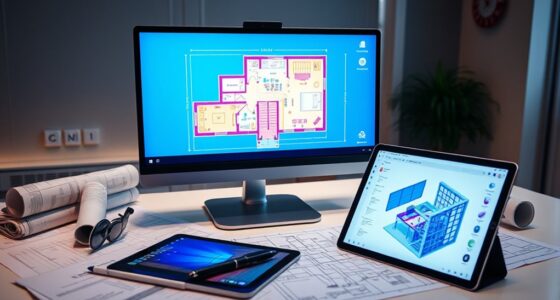To create an energy-efficient HVAC layout, start by evaluating your building’s needs and perform load calculations to size equipment properly. Strategically place ductwork and vents near room centers, keep runs straight, and seal leaks to minimize energy loss. choose high-efficiency units with smart controls, and design your system with zoning to optimize airflow. Incorporate automation to adjust for occupancy and weather. Keep reading to discover how these strategies can maximize your system’s performance.
Key Takeaways
- Conduct comprehensive load calculations to size HVAC equipment accurately for optimal efficiency.
- Strategically position ductwork and vents near room centers, minimizing bends and length to reduce energy loss.
- Implement zoning with dampers and thermostats for targeted heating and cooling control.
- Select high-efficiency, ENERGY STAR-rated units with variable-speed fans for adaptable operation.
- Incorporate smart controls and automation for occupancy-based adjustments and remote system management.
Assessing Building Needs and Load Calculations
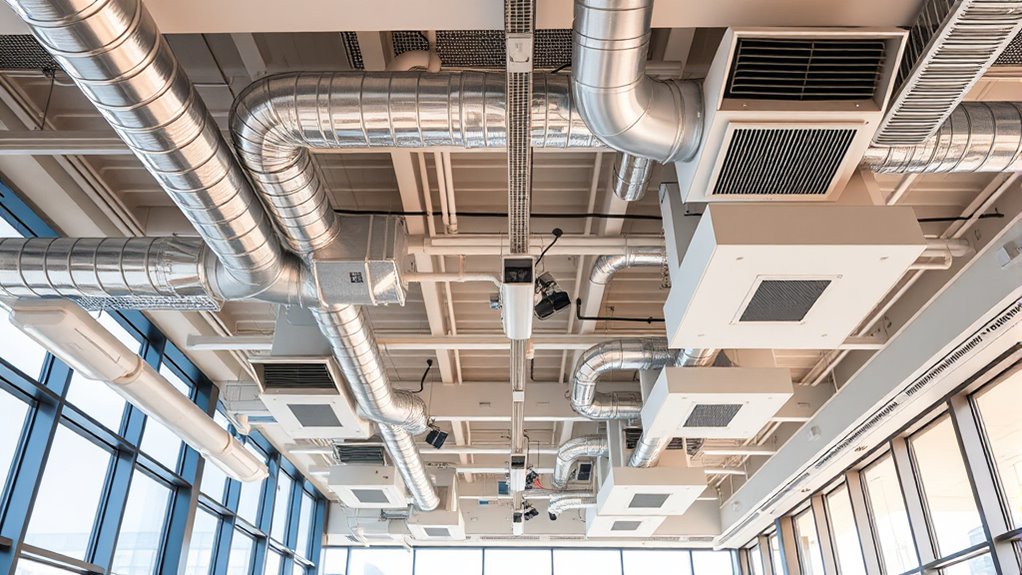
Before designing an energy-efficient HVAC system, you need to accurately assess the building’s needs and perform load calculations. This step guarantees your system matches the space’s heating and cooling demands, preventing energy waste. Start by evaluating factors like building size, insulation quality, window placement, and occupancy levels. Use this data to determine the heating and cooling loads, which indicate how much energy is required to maintain comfortable conditions. Proper load calculations help you select appropriately sized equipment, avoiding oversized units that cycle frequently or undersized units that struggle to meet demands. Additionally, consider local climate conditions and building usage patterns. Taking these steps ensures your HVAC system operates efficiently, reduces energy consumption, and guarantees optimal comfort for occupants. Incorporating noise levels of modern heat pumps into your planning can also enhance overall system performance and occupant comfort.
Strategic Placement of Ductwork and Vents
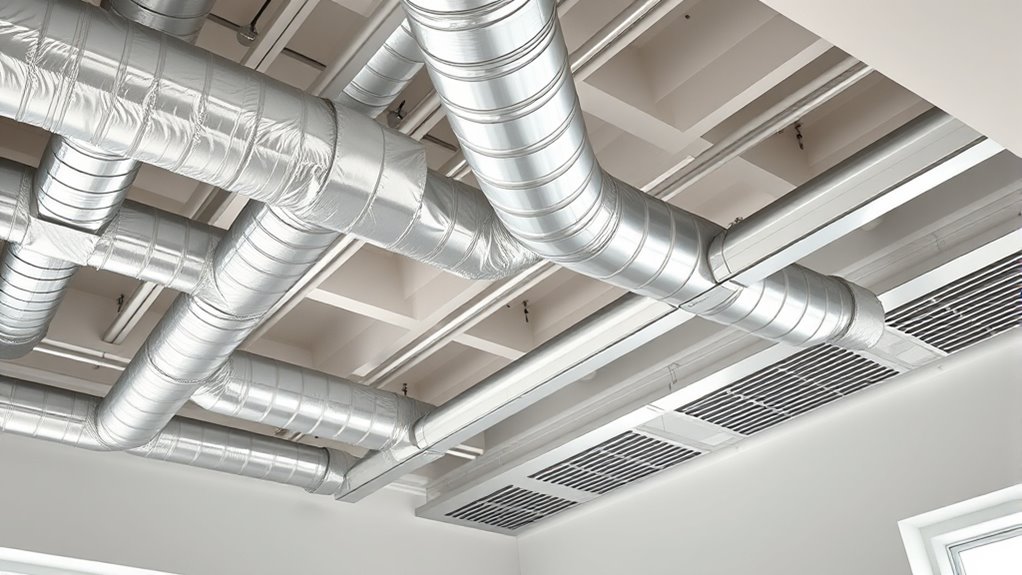
Have you considered how the placement of ductwork and vents directly impacts your HVAC system’s efficiency? Proper placement ensures even air distribution throughout your space, reducing hot or cold spots. Position vents near the center of rooms and avoid blocking them with furniture or curtains. Keep duct runs as straight and short as possible to minimize energy loss from friction and leakage. Sealing gaps and leaks in ducts prevents conditioned air from escaping, maintaining consistent temperatures. Additionally, zoning sections of your home allows you to control airflow based on usage, saving energy. Incorporating airless spray technology into your maintenance routine can improve the overall efficiency of your HVAC components. Strategic placement not only enhances comfort but also reduces the workload on your HVAC system, leading to lower energy bills and improved system longevity. Proper planning makes your system more effective and efficient.
Selecting Energy-Efficient Equipment and Components
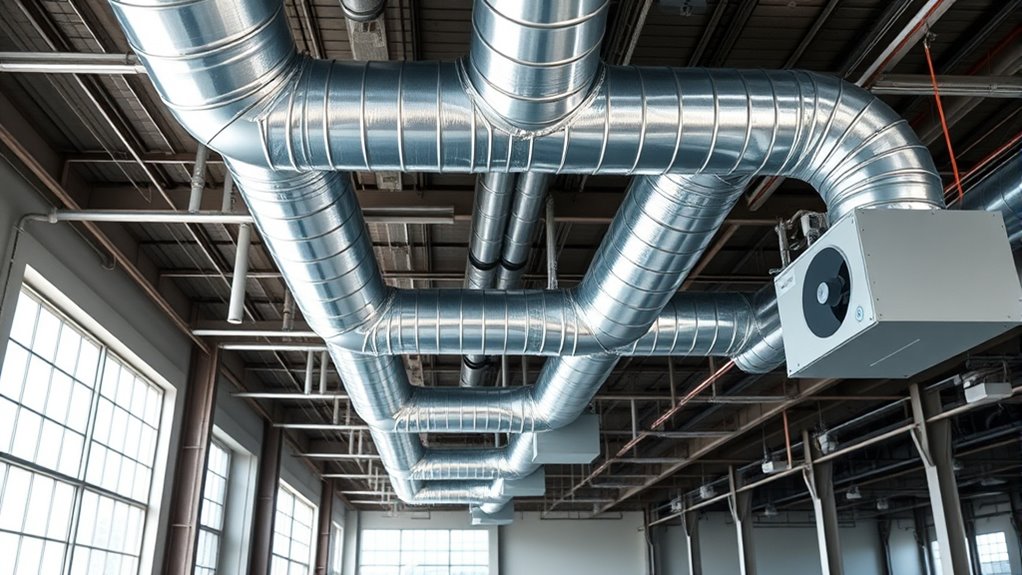
Choosing the right equipment and components plays a vital role in maximizing your HVAC system’s energy efficiency. Start by selecting high-efficiency units like ENERGY STAR-rated furnaces and air conditioners. Variable-speed fans and smart thermostats help regulate energy use without sacrificing comfort. When choosing components, consider insulation and sealing materials, which reduce unnecessary energy loss. Here’s a quick guide:
| Equipment/Component | Key Benefit | Tip |
|---|---|---|
| High-efficiency furnace | Lower energy bills | Look for ENERGY STAR labels |
| Variable-speed blower | Precise airflow control | Match with your system size |
| Smart thermostat | Optimizes heating/cooling schedules | Program for efficiency |
Invest wisely in these components to guarantee your HVAC system runs efficiently and saves energy long-term.
Designing for Airflow Optimization and Zoning
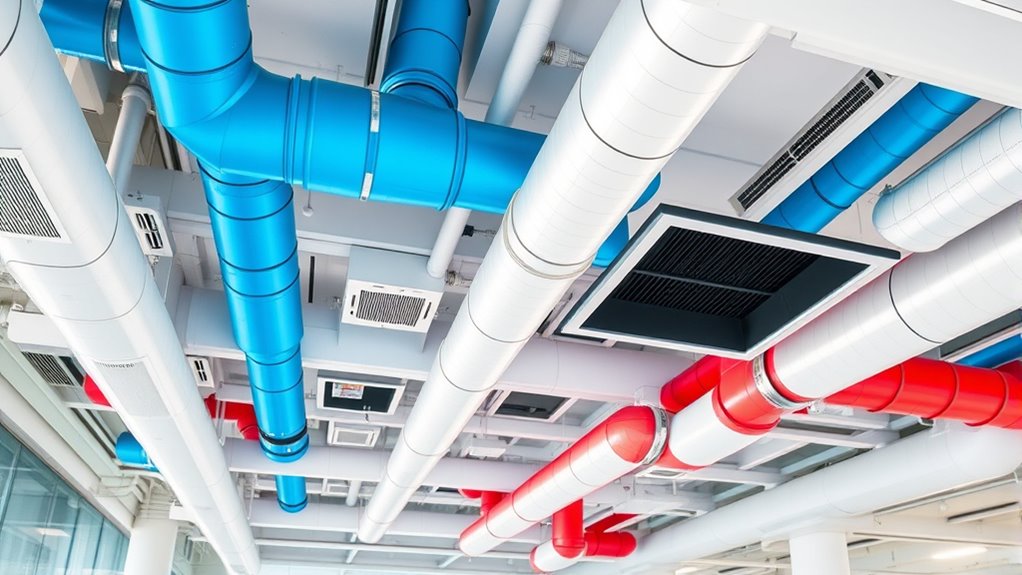
Effective airflow design is essential for maximizing your HVAC system’s efficiency and comfort. To achieve this, plan your ductwork carefully, ensuring it minimizes bends and length, reducing energy loss. Use zoning to divide your space into manageable sections, allowing you to control temperatures precisely where needed. Install dampers and thermostats in each zone to fine-tune airflow and maintain consistent comfort levels. Properly sized vents and registers ensure balanced airflow, preventing hot or cold spots. Incorporate airflow analysis during design to identify potential bottlenecks and improve distribution. Additionally, understanding airflow optimization principles can help you design a more efficient system. By focusing on airflow optimization and zoning, you’ll reduce unnecessary energy consumption, enhance system performance, and create a more comfortable environment tailored to your space’s specific needs.
Incorporating Smart Controls and Automation
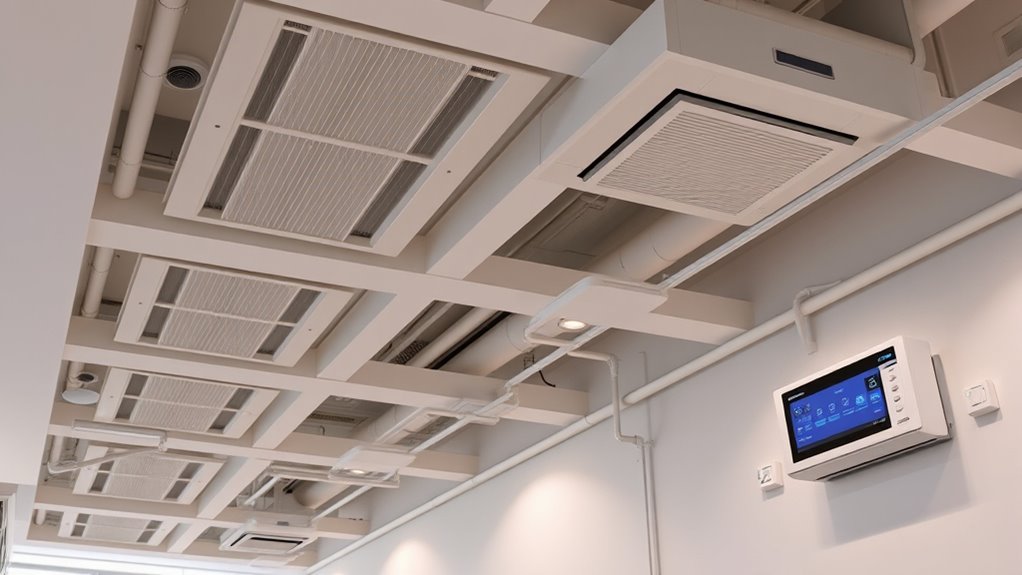
Incorporating smart controls and automation can considerably enhance your HVAC system’s efficiency and convenience. By installing programmable thermostats and sensors, you can adjust temperatures based on occupancy, time of day, or weather conditions, reducing energy waste. Automated systems can learn your routines, optimizing heating and cooling without manual input. You can remotely monitor and adjust settings via smartphone apps, ensuring comfort while saving energy when you’re away. Integration with home automation allows your HVAC to work seamlessly with lighting, blinds, and security systems. Implementing these technologies not only improves system responsiveness but also helps identify inefficiencies and irregularities early. Overall, smart controls and automation make your HVAC system more intuitive, energy-efficient, and aligned with your lifestyle. Recognizing relationships between different system components can further optimize overall performance.
Conducting Regular Maintenance and System Evaluation
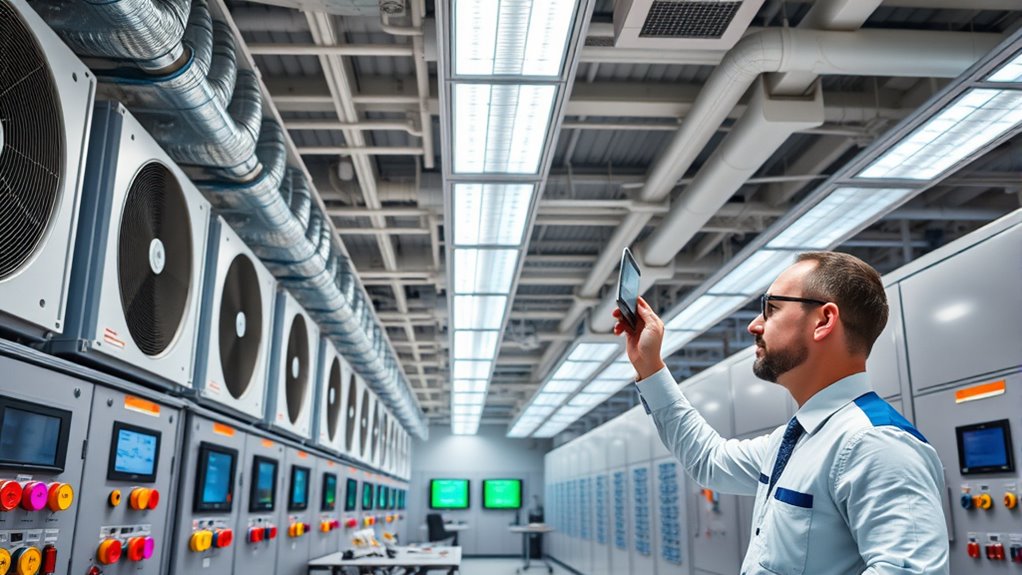
To guarantee your HVAC system operates at peak efficiency, regular maintenance and system evaluation are essential. By staying proactive, you can prevent costly breakdowns and optimize energy use. Here are three key steps:
- Schedule professional inspections at least twice a year to identify and fix issues early.
- Change filters regularly—preferably every 1-3 months—to ensure proper airflow and air quality.
- Monitor system performance by tracking energy bills and comfort levels, making adjustments as needed. Incorporating regular cleaning of filters and components further enhances system efficiency and longevity.
These practices help your system run smoothly and efficiently. Regular maintenance not only prolongs your HVAC’s lifespan but also reduces energy consumption, saving you money over time. Keep your system in top shape to maximize energy savings and indoor comfort.
Frequently Asked Questions
How Does Insulation Affect HVAC Energy Efficiency?
Insulation plays a vital role in your HVAC system’s energy efficiency. It helps keep the desired temperature steady by reducing heat transfer through walls, ceilings, and floors. When your home is well-insulated, your HVAC system doesn’t have to work as hard to maintain comfort, saving energy and lowering costs. Proper insulation minimizes drafts and cold spots, ensuring your system runs smoothly and efficiently all year round.
What Are the Best Materials for Duct Insulation?
When choosing duct insulation materials, you want options that minimize heat transfer and boost efficiency. You should consider materials like fiberglass, which is lightweight and offers excellent thermal resistance, or foam board insulation, known for its high R-value. Reflective foil insulation can also help by reflecting heat. Confirm the material you select is durable, moisture-resistant, and suitable for your climate to keep your HVAC system running efficiently.
How Can Solar-Powered HVAC Systems Be Integrated?
Many believe solar-powered HVAC systems are too costly or complex, but they’re actually quite feasible today. You can integrate solar panels with your existing system by installing photovoltaic panels on your roof and connecting them to a battery storage unit. This setup reduces reliance on grid power, cuts energy costs, and promotes sustainability. Proper planning and professional installation guarantee your solar HVAC system works efficiently, saving you money and the environment.
What Is the Lifespan of Various HVAC Components?
You might wonder about the lifespan of HVAC components. Typically, you can expect your filters to last 1-3 months, while your condenser and furnace can operate efficiently for 15-20 years with proper maintenance. Compressors last around 10-15 years, and thermostats often need replacing every 10 years. Regular upkeep helps extend these lifespans, ensuring your system runs smoothly and saves you money in the long run.
How Do External Factors Influence HVAC Energy Consumption?
While the current question gently explores external factors, you should know they substantially influence your HVAC energy use. Weather conditions, like extreme heat or cold, make your system work harder, increasing energy consumption. Additionally, building insulation, sunlight exposure, and outdoor air quality play subtle roles. By understanding and managing these factors, you can optimize your system’s efficiency, saving energy and reducing costs over time.
Conclusion
By applying these energy-efficient HVAC strategies, you’ll create a comfortable, cost-saving environment. For example, imagine a commercial building that reduces energy bills by 30% after optimizing duct placement and installing smart controls. Regular maintenance guarantees everything runs smoothly, preventing costly issues. With thoughtful planning and smart technology, you can enjoy a more sustainable space that saves money and enhances comfort—making your building smarter, greener, and more efficient every day.



